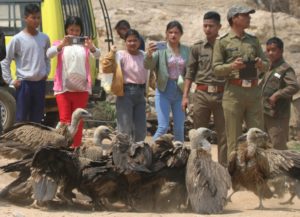By Kynsai Ria Kharkongor
About forty Himalayan Vultures arrived in Demthring village in Jaintia Hills in March. These birds live in Tibet and the higher reaches of the Himalayas and migrate to warmer regions during the winter. According to a sixty-year old woman in the village, the vultures have been seen every winter and spring since her childhood, but in much smaller numbers, usually less than ten. They arrive around late winter and stay till the rains commence. The birds roost in the trees along a nearby river. This year they are more conspicuous, flying during the day to the roadside attracted by the meat shops.
 Among the nine species of vultures that inhabit the subcontinent, Himalayan vultures are the largest, standing about 3 ½ feet high, weighing up to 12 kg, and have a wingspan of 9 feet. These dark brown birds have heavy curved beaks, loosely arranged feathers with gold streaks on the wings and upperparts. The long neck is covered with short white feathers, giving it a downy or woolly look. Females are slightly larger.
Among the nine species of vultures that inhabit the subcontinent, Himalayan vultures are the largest, standing about 3 ½ feet high, weighing up to 12 kg, and have a wingspan of 9 feet. These dark brown birds have heavy curved beaks, loosely arranged feathers with gold streaks on the wings and upperparts. The long neck is covered with short white feathers, giving it a downy or woolly look. Females are slightly larger.
Like all vultures, they feed mostly on carcasses. They soar high above the ground in warm thermals, scanning the landscape for dead animals. Their excellent eyesight helps them locate dead animals from thousands of feet above. They start circling around when they find food to signal to other birds. They are social creatures, living and feeding in flocks. A flock can devour a dead sheep, including the bones, within 30 minutes. They are usually silent but hiss and grunt while feeding.
Vultures are ecologically important as nature’s scavengers. They have strong acids in their stomach that kill bacteria in rotten flesh. The acid also dissolves bones. They aid in the disposal of animal waste and prevent spreading diseases to other animals and humans.
All vultures are endangered and Himalayan Vultures are listed as ‘Near Threatened’ in the The International Union for Conservation of Nature (IUCN) Red List. The main cause of the declining population of vultures is the veterinary drug diclofenac, commonly given to domestic cattle that causes kidney failure in vultures. In Tibet, the main diet of vultures are domesticated yaks.
These predatory birds are residents of the Himalayas and the Tibetan Plateau, living at elevations up to 14 thousand feet. In the winter, they build large bulky platform nests of sticks on cliff edges, usually in colonies. Each pair lays one large white egg, splotched with red. The fledglings leave the nests by March and join the adults in migrating to parts of north and northeast India.
Why do the vultures come to Demthring? Perhaps because of food, water and roosting sites. In years past, the villagers would slaughter livestock near the river and leave the waste bits of meat and bones there. This provided food for the vultures. Like aeroplanes, these huge birds need runways to take off and land. The open sloping hillsides are ideal for these flight patterns. They roost at night in the tall clumps of pine trees. Himalayan vultures have been observed feeding on pine needles, an unexplained behaviour that could be meeting a nutritional need.
From ancient times, vultures have been portrayed in various cultures. The goddess Nekhbet, protected the pharaohs of Egypt. She was frequently portrayed as spreading her wings over the pharaoh, and sometimes suckling the pharaoh, providing sustenance. The Parsis place their dead in Towers of Silence, open to the sky, leaving them to be consumed by vultures. Sky burials are an ancient practice among the Tibetans. They believe that if vultures eat the body, it means that sin has been erased and that the soul has gone peacefully to paradise.
“These birds have been visiting our village since I was a little girl, almost fifty years ago,” said one of the locals. According to her, the vultures come every year in early March. The birds spend the day soaring above the hills near the river. The birds are called ‘syngkni’ in Pnar and ‘pukni’ in Khasi. The people of Demthring are happy that these birds visit them, saying “they don’t harm us, so we don’t harm them”. The vultures are unafraid of humans and dogs. Attracted by the huge birds, cars often stop at Demthring and people even take selfies with the vultures. The forest department has stationed a few officers at Demthring. These uniformed staff make sure the birds are unharmed.



